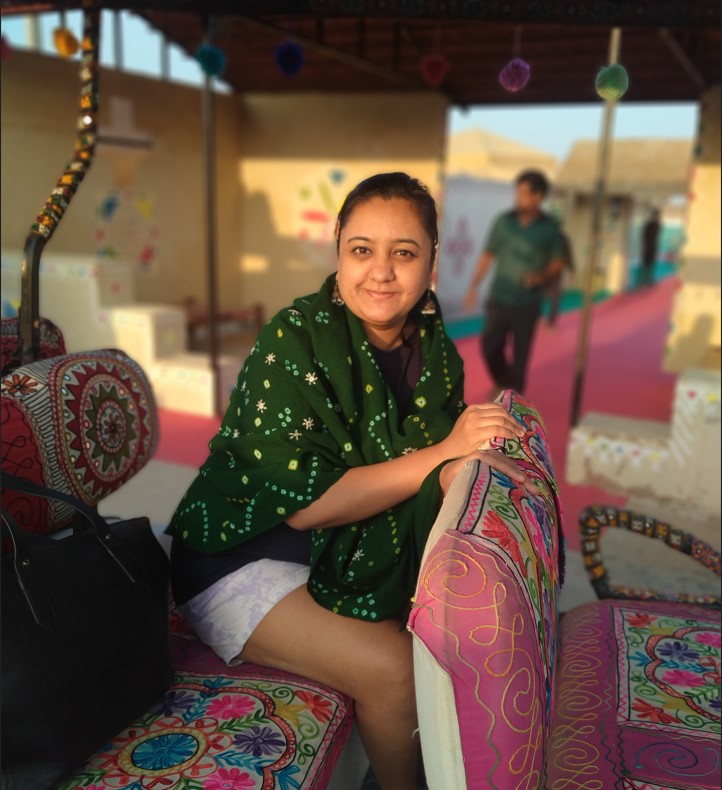By Nivi Shrivastava
Every time one thinks of Gujarat, memories of eclectic flavours and array of colourful visuals pop up instantly. Of course, the prehistoric monasteries, ancient temples and step-wells, colourful alfresco Havelis, and heritage monuments will always be the key tourist attractions for first-time visitors; however, for an art-loving curious traveller there’s a lot more to discover and take home while exploring the vivid range of handicrafts across the State.
Vivacious weaves:
In the Raj era, the humble khadi weaves from Gujarat were popularized by the Mahatma as a sign of rebellion and self-sustainability; however, the gorgeous Patola weaves from the Patan District are the crowd-puller for any textile lover. A must-have in traditional Gujarati bride’s trousseau and centuries of royal patronage for this weave makes it a star textile from the state. The complex double ikat dyeing technique involved in making Patola saris on a handloom makes it rare and expensive, but worth investing as the original would cost you INR 1,50,000 and above. Only a handful of weaver families, who know the art of weaving these saris, spend several months finishing the six-yard wonder that claims to never lose its original colour.

Precious arts of Kutch:
In the list of exclusive handcrafts, a noteworthy addition is the Rogan textile painting that’s done exclusively by the Khatri family of Nirona village in the Kutch district. The artist Abdul Gafar Khatri, whose family practices this unique art form for generations, has won the Padmashri award for preserving this form of textile art that traces its origin from Persia. Speaking to DH Online, he mentions, “The oil-based colour intricate patterns are created on cloth using this one-of-its-kind art. It is a prized possession for collectors and our PM Modi has gifted some of these artworks to names like President Obama, Queen of the Kingdom of Denmark, Margrethe II and recently to Japan’s PM Fumio Kishida.”
The Nirora village is also home to the quaint iron-copper bells that are made from scratch using hand-beaten metallic plates that are blended and crafted without any joints. For cooking enthusiasts, this village has an interesting area for buying handmade lacquer rolling pins on wood with multiple colours and designs. Head to Kutch for the glittering mirror work on traditional attires, dupattas, shawls, tapestries, and bags, and sample the popular ‘Shisha’ or ‘Abla’ embroidery. The signature round mirrors put together on fabric using cross-stitch by the embroiderers of Kathiawar are available across the state.

Brilliant shades of Saurashtra:
Whereas, the Kutch and Saurashtra regions are also famous for the effervescent tie-and-dye (bandhani) technique on natural fabrics, which is practiced extensively as family trades in communities of Pethapur, Mandavi, Bhuj, Anjar, Jetpur, Jamnagar, and Rajkot towns. The famous Red Bandhani of Bhuj is especially popular as the local artisans believe the salty water of this city adds a peculiar hue to the red and maroon shades of natural colours used in the process. The love for vivacious patterns is a common theme that one can find in almost every art and craft in Gujarat, and most ancient techniques involve vegetable dyes and mineral colours to evoke the traditional roots for sustainable practices. In the Ajrakhpur village of the Kutch district, the age-old block printing art called Ajrakh is still practiced as a community trade by the local artisans. The hand-block printing designs and dyeing process in layers are created using several blocks and it is a cumbersome process, making these prints exclusive and highly coveted in fashion circles.
Nomadic inspirations:
A lot of handcrafts that are prominent in Kutch take inspiration from nomadic Sindh and Baloch tribes that carry forward these ancient practices within their communities. One such craft is the leather embroidery by the Marwadi Meghwal community of Kutch, who buy animal hides from the Maldhari cattle herders to create embellished shoes, bags, and wallets for men and women. The list of collectibles could also include the painted votive terracotta horses, elephants, and human figurines from the Sabarkantha district of Gujarat. A lot of rural homes in Kutch and Saurashtra still create earthen clay pots and utensils using techniques that were followed by the Indus Valley civilization.

Pitstop at Surat:
Perhaps, a lesser-known but signature textile from the looms of Madavi and Surat is the Mashru weave, which is a glossy double-faced fabric created using blends of cotton and silk threads accentuated with ikat stripes. From weaves to embroidery, Surat can be a pit stop to check out the exquisite zari work (aka zardozi) created using blends of silk, cotton, and copper threads, used in clothing and décor items. Surat is also known to be the hub for Sadeli woodwork, where intricate floral and/or geometric patterns are carved by artists on teak boxes, cupboards, doors, bedposts, and chests for a distinctive mosaic aesthetic.
(The writer’s trip was organized and sponsored by Gujarat Tourism. To reach her write at [email protected])
